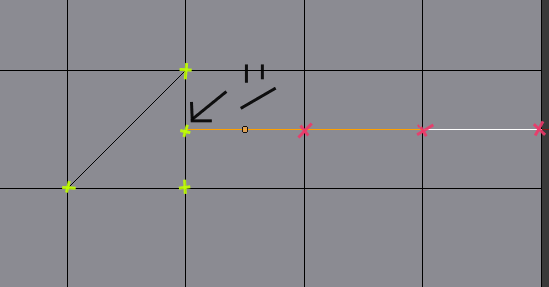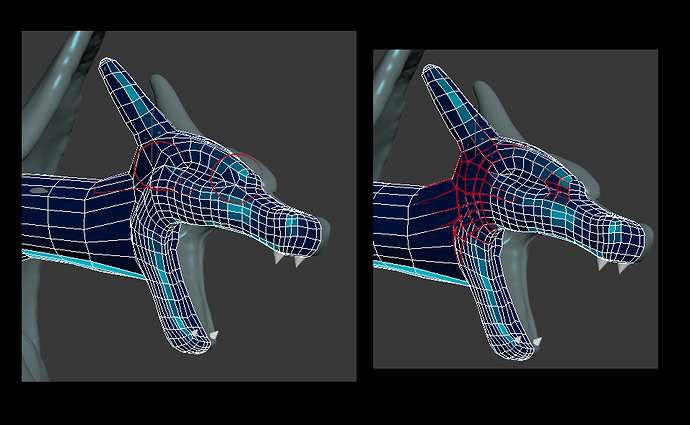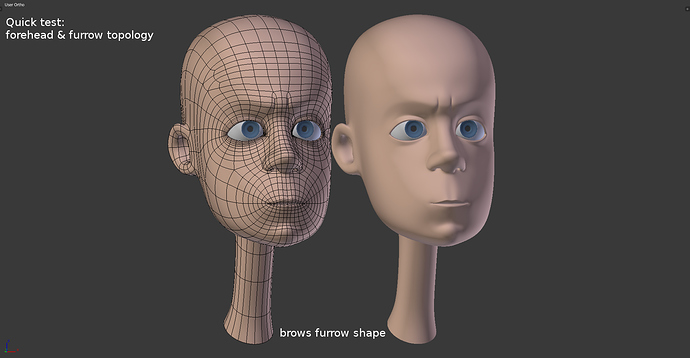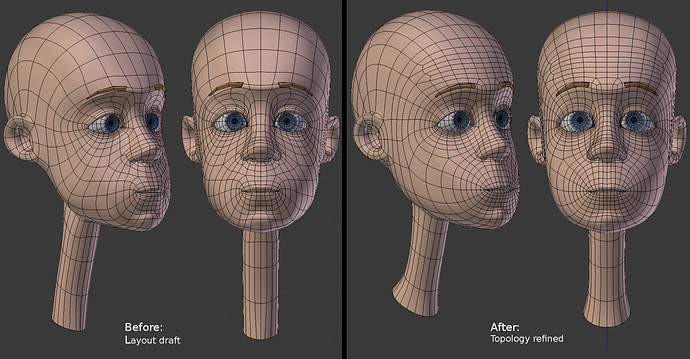100% quads not needed - 90% quads / 10% tris. -tris. would not be much:) Excellent topology is an art and it shows on the skills and talents modeler.
For a game engines can be tris . more… because engine it just transferred everything into triangles:D
Old times when game characters modeled with a triangles only are gone.
All quads is ideal, however it’s fine to use some tris.
Ngons not good most all of the time, only exception is on flat surfaces (that will remain flat).
Best practice is to keep it as clean as possible and have decent edge/face loops.
Spiders (where 5 or more quads meet) are unavoidable sometimes, when you have a spider try to make sure it’s on a flat or only slightly curved surface NOT on any hardish/hard edges.
That area I circled in doesn’t deform so well to me. That little kite shape I drew on the right side is that is typically used to reduce the number of edge-loops in a model 9 out of 10 times most people hide that above the hair line so that you don’t have too many poles on the brows, on Victor that kite is on his brows. Even when his brows are not in mid-up position like in the picture I attached and are relaxed you will notice that weird creasing on his brows
Also some of those lines on his brows should be depressions but are rised on Victor, I included a screen cap I took of Helen from The Incredibles as a comparasion
As someone who had epic bad topology, I’ve been actively trying to improve, and I think it does matter a lot. I went from never even being able to realistically tackling a human head to this in a matter of a day:
I know he’s not perfect with the angry eyes, there’s a few derped up quads and his ears were modeled separate and hacked on with a bunch of triangles - but not too bad for a first attempt, at least a first attempt that didn’t end up in a tangled mess of ngons that didn’t really resemble a head at all.
Good topology helps make me sense of things in a reasonable way. It’s easier to organize forms in a way that makes sense and break down shapes into polygons. Ever since attacking the problem of topology my modelling skills have improved 10-fold, and I’m starting to feel like options have really opened up for me.
The thing to remember is that keeping things quad-only doesn’t necessarily make for good topology.
With todays high poly workflow topology shouldn’t matter until it comes to re-topology where a good understanding of sub-d best practice is preferable. Soon it will no longer an issue as auto re-topology tools become more efficient in recognising animation constraints.
A good modelling package is one that frees the artist from technical considerations, i think the cg world is moving on from old established workflows, we should be more concerned about proportions an design over quads and triangles.
Thanks for pointing that out. I didn’t notice it at first. You would indeed expect the crease across the top of the nose to occur when he is frowning, not when raising his eyes brows. Well spotted!
The brows are borderline passable, but those mouth corners… Man, that’s creepy.
Quad topology, mostly does matter about the productivity of the pipeline. For example a consistent edgeflow makes things much better and sane when editing the model. And also when delivering you get the technical benefits as well as other say about shading, unwrapping and deformations.
Most important are the game engines when it comes to topology, where really optimized topology is the only way to go and helps the system generally.
However there are times when 100% of quad topology is unwanted, I have seen in various tutorials that in order to maintain the 100% quad topology people start to make weird edgeflows, or spawn extra vertices, like in this case. Also the most paranoid cases are when the edge loops look like roller coaster tracks and make weird shapes.

I like to keep things very simple, I just escape the edgeloops and hide these triangles to insignificant areas, generally flat surfaces, or surfaces that not fully visible.
For example in a character these would be behind the ear, under the hair, under any equipment, behind the kneecaps, under the armpits, etc.
There is nothing to stop you for going back to object mode and doing a retopo pass. Allot of topology issues go away when you only have to worry about the topology and its flow. Rather then all of that plus the form of what you are making.
“Topology” matters a great deal. Good topology is absolutely essential for facial animation, especially when mocap is involved. For stuff like hard-surface modeling where the geometry won’t deform and the areas are mostly flat it’s okay to have “bad” tolopogy.
A “good” topology is one that get’s the job done and a good modeler decides when they can be a little bit sloppy with it.
I am seriously considering changing my username to “derpy quads”.
For example, here is a sample -bad topology areas on the dragon head… and my solution as I would do it 
…to have or try the best topology a lot matters :yes:
Attachments
Something else to always keep in mind is … “try to figure out first where the camera is going to be.” What’s going to be visible or not … what’s going to be close-up or not … what’s really important to the show or, uhh, not.
If it is TAP = The Almighty Product, then it might well justify lavish attention to the model (or models) of that particular thing. But if something’s only going to be seen from one angle, you might not even build the other side. If something’s going to be seen in both a medium-shot and an extreme close-up, the ECU’s model might be different. (And it might well end “one inch beyond the edge of the camera’s field-of-vision,” so you need to know exactly where that boundary is going to be.) Movie sets are always “skin deep.”
Modeling time is expensive, and difficult to recoup. Try to plan ahead, but “if it works, don’t fix it.”
The only bad modelers are the ones who are still learning or just starting out.
This is my experience with the topic:
topology does matter, but it depends on your situation if it matters enough to spend the effort (Like SterlingRoth mentioned above)
But also, which kind of topology you need, depends on what you are doing.
For a low-poly 3d game, in some cases, you want to work with tris because if you use quads the exporter might triangulate in the wrong direction.
For organic shapes, quads is generally the best approach
For architecture and mechanical modeling, it may make more sense to have n-gons. However then it is still important to ensure they are flat, and not too stretched or concave.
Does seem like a strange deform from that angle. But the kite is not where you pointed - at lease as I interpret your drawing.
The kite was added for a specific purpose to aid in a brow wrinkle that would easily terminate right above the brow.
Angela also spent the week playing with the topology of Victor’s face. Check out some of his expressions using the new topology above.
As you can see from the above image, the extra topology was added for two purposes. One to add wrinkles and second to terminate them in specific places which also steps down the geometry at the same time.
In LightWave there was an old Plugin called Wrinkle or something like that. It would split edges and automatically terminate them in kites as you see above.
For those who say “all quads is optimal”: Keep in mind that after the first subdivision iteration all triangles will have been turned into quads, possibly creating topology that isn’t undesirable or that you may have otherwise created by hand anyway. I would argue that an optimal mesh is one that has the least possible amount of control geometry required to achieve the desired result. Obsessing over all-quad topology seems counter-productive in this regard.
Yeah that’s true but anything that is non-quad when subdivided give you will have quads with poles. Poles can be just as problematic to deal with as n-gons and triangles especially on organic models where the few flat surfaces to hide them.
Personally when I think of topology been 100% quad is the least important thing edge loops are what I focus on especially for faces.
Unless you are modeling a torus or so, poles are unavoidable. I’m not saying triangles or poles can’t cause problems, but wherever you could’ve used a triangle, you likely would’ve ended up with poles anyway.







